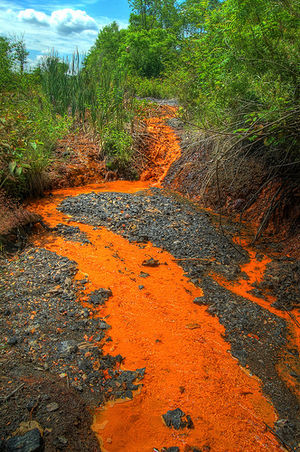Acid mine drainage
Introduction

Acid mine drainage (AMD) occurs when metal sulfides, most commonly pyrite, are exposed to and react with air and water. When water flows over or through sulfur-bearing mine tailings, a chemical reaction occurs between the water and rocks resulting in metal-rich water. AMD typically has a bright orange, yellow, or bownish-red color to it. The mine drainage is acidic, as its name states, and found around ore and coal mines. Abandoned and currently operating mining activities contribute to AMD. Metal rich drainage can also occur in areas that have not been mined. Areas like construction sites and other places that have been highly disturbed can exacerbate natural rock weathering processes leading to acidic drainage.
An area heavily mined for coal, therefore greatly impacted by AMD, is the mid-Atlantic region in the middle of the Appalachian Mountains. Here, and everywhere AMD occurs, has a highly altered ecosystem. The greatest consequence of AMD is water pollution. This in turn results in contaminated drinking water, damage to aquatic flora and fauna, and corrosion of man-made infrastructure.
Microorganisms like bacteria and archaea significantly affect AMD. When metal sulfides, usually pyrite, that are contained in rock are exposed to water and air, an oxidation reaction takes place. Microbes speed up the decomposition of these metal ions. Microorganisms also play a huge part in the bioremediation of AMD. Techniques that are being researched include using metal-immobilizing bacteria, biocontrol with bacteria and archaea, and bioleaching.
Physical environment
Physical Characteristics
Subsection 1a
Subsection 1b
Chemical Characteristics
Subsection 2a
Biological interactions
Are there important biological interactions that are important in this environment? Do these interactions influence microbial populations and their activities? How do these interactions influence other organisms? Describe biological interactions that might take place in this environment, using as many sections/subsections as you require. Look at other topics available in MicrobeWiki. Create links where relevant.
Subsection 1
Subsection 1a
Subsection 1b
Subsection 2
Microbial processes
What microbial processes define this environment? Describe microbial processes that are important in this habitat, adding sections/subsections as needed. Look at other topics in MicrobeWiki. Are some of these processes already described? Create links where relevant.
Subsection 1
Subsection 1a
Subsection 1b
Subsection 2
Key Microorganisms
What kind of microbes do we typically find in this environment? Or associated with important processes in this environment? Describe key groups of microbes that we find in this environment, and any special adaptations they may have evolved to survive in this environment. Add sections/subsections as needed. Look at other microbe listings in MicrobeWiki. Are some of the groups of microbes from your environment already described? Create links to those pages. Specific microbial populations will be included in the next section.
Subsection 1
Subsection 1a
Subsection 1b
Subsection 2
Examples of organisms within the group
Acicithiobacillus ferrooxidans, Acidithiobacillus thiooxidans, and Leptospirillum ferrooxidans and related species
Current Research
Enter summaries of recent research here--at least three required
References
Edited by student of Angela Kent at the University of Illinois at Urbana-Champaign.
